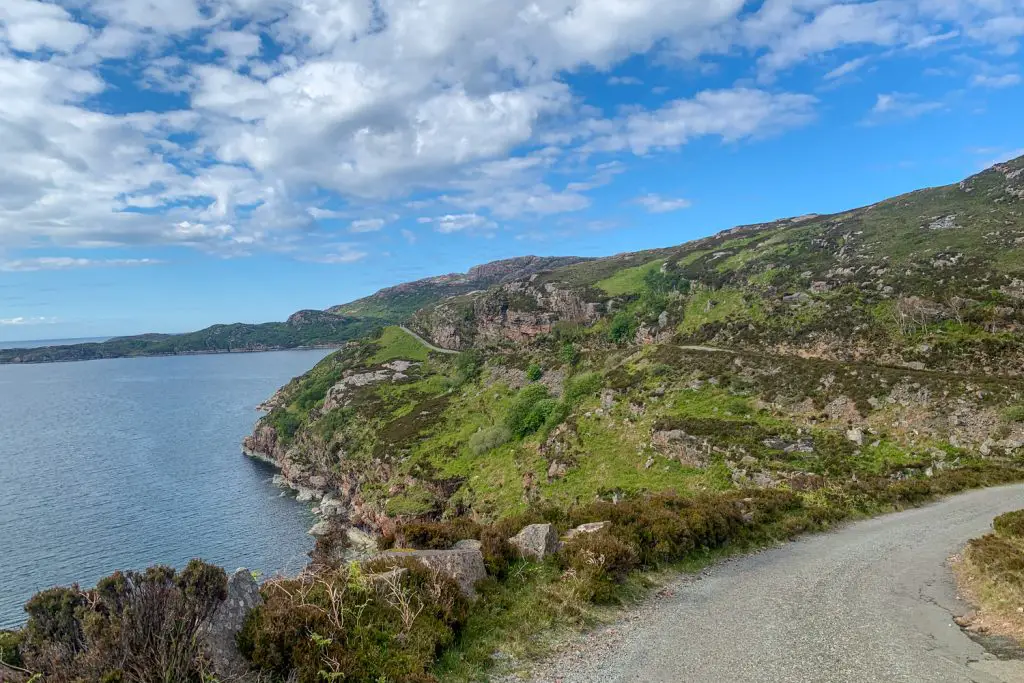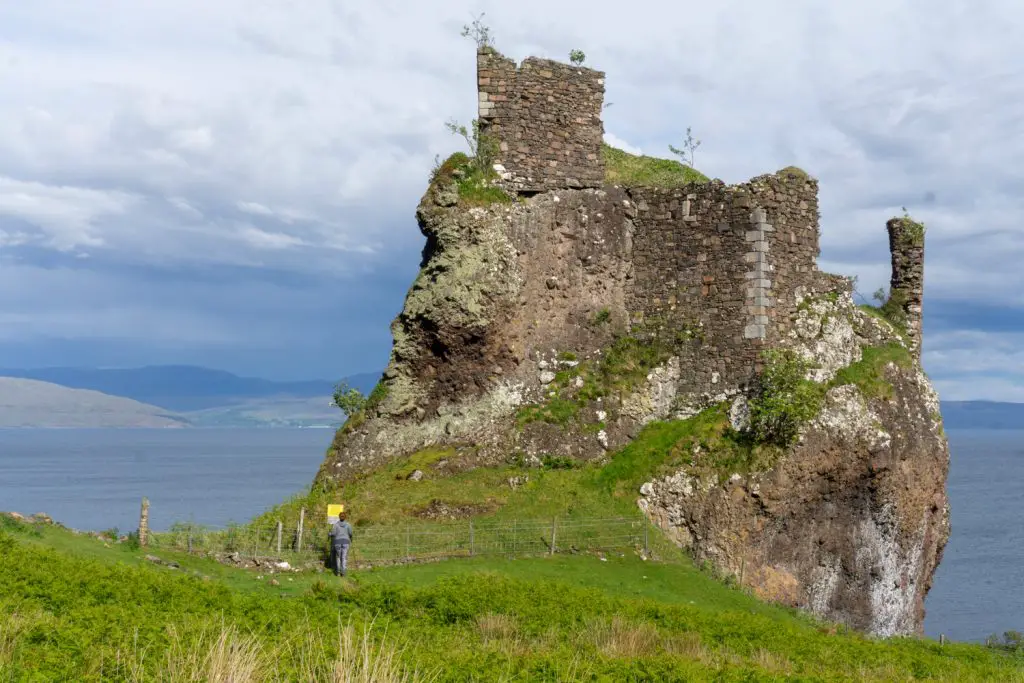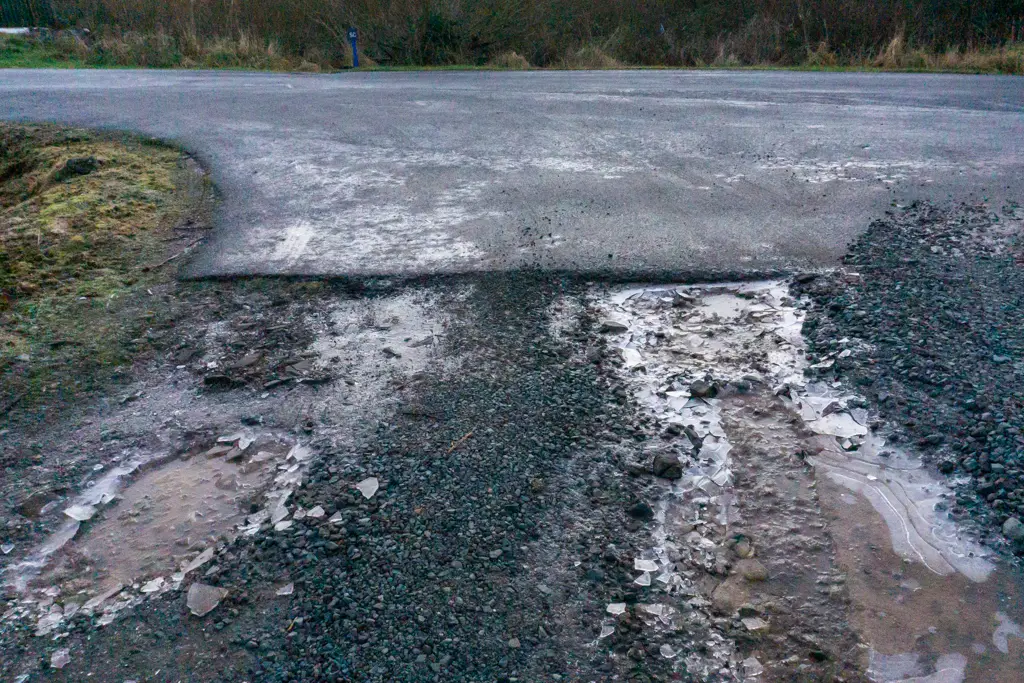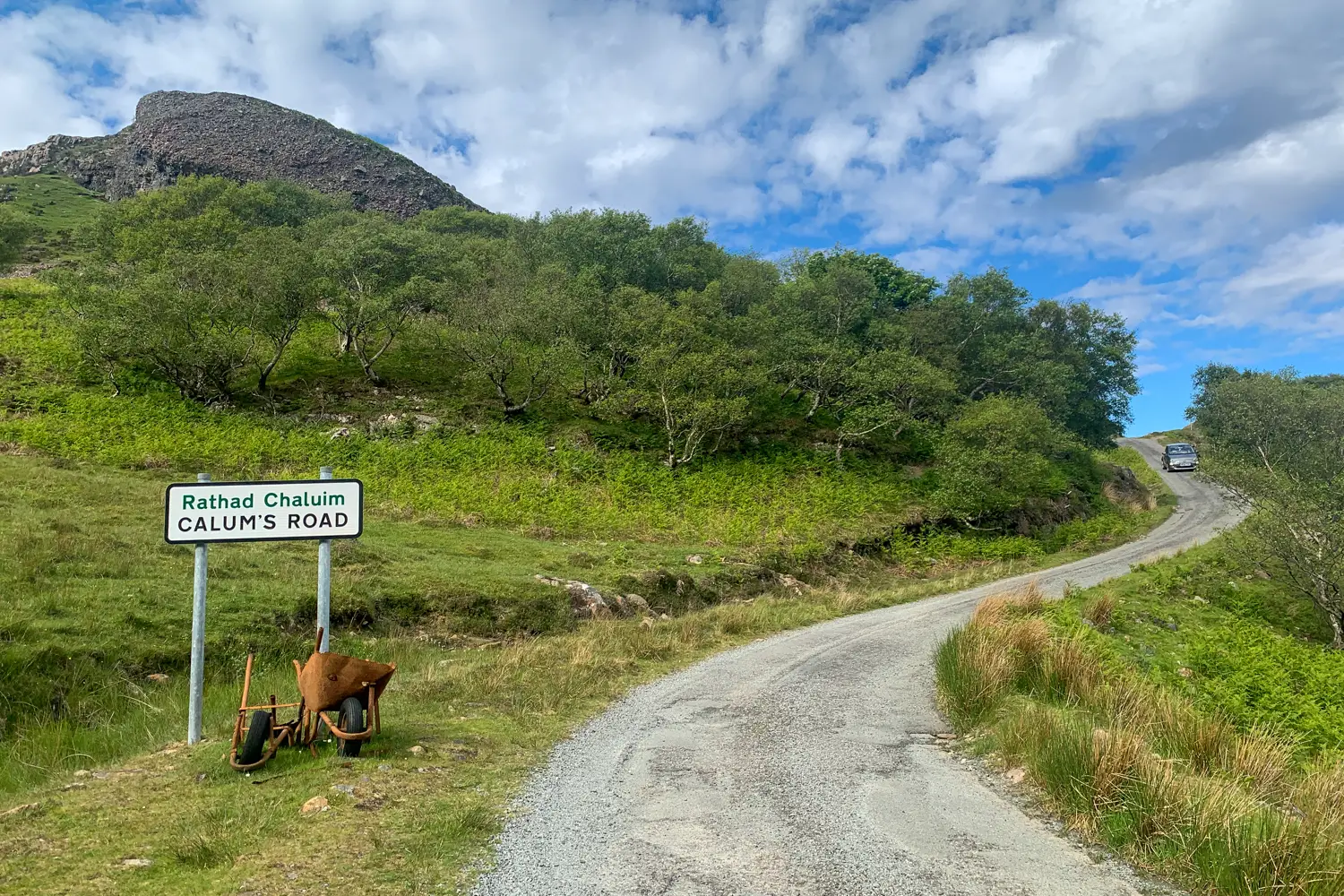When you’re looking up the best things to do on the Isle of Raasay, Calum’s Road is likely to be something that you read about. This unlikely tourist attraction might be somewhat underwhelming when compared to the epic landscapes on the neighbouring Isle of Skye, however, it sure does have a great story behind it.
If you’re heading to the Isle of Raasay and want some context for your visit, this short post will tell you everything you need to know about Calum’s Road, from the history behind the track, to what to see en route and some tips for driving on it.
Read more: (opens in new tab)
- Best Walks on the Isle of Raasay
- Amazing Day Trips from the Isle of Skye
- Incredible Walks on the Isle of Skye
A Guide to Calum’s Road, Isle of Raasay
A Brief Introduction to the Isle of Raasay
Part of the Inner Hebrides, the Isle of Raasay is located off the west coast of Scotland, just a 25-minute ferry journey from the Isle of Skye. It is much less visited than Skye, however, the island is equally beautiful in its own way.
The island isn’t very big and there are only 140 permanent residents living there. Of these, 10% work at Raasay Distillery! As the island is so small (14 miles long by 3 miles wide), there is only one main road which runs from the ferry terminal in the south, right up to northern Raasay.
The History of Calum’s Road
Prior to the construction of Calum’s Road, everything north of Brochel was unreachable by road. The road stopped close to Brochel Castle, nearly two miles from the most northern settlement of Arnish. If the inhabitants of Arnish wanted to journey south, they had to walk the two miles to Brochel to join the road.
Local crofter and Arnish inhabitant Malcolm Macleod, better known as Calum, appealed numerous times to the local council to get them to extend the road to Arnish, however, time and time again, his request was denied.

Fed up with the constant refusal from the council, Calum decided to build the road himself. He picked up a copy of Road Making & Maintenance by Thomas Aitken, a pick, shovel and wheelbarrow and got to work.
The road took around a decade to construct, most of which Calum did solo with his own bare hands. By the time the road was completed, depopulation was in full swing in the north of the island and the only inhabitants that remained were Calum and his wife Lexi.
Once the road was finally finished, the council adopted it and took charge of surfacing it. Ironically, Calum used his road to travel between Arnish and Brochel but never ventured further south by car as he didn’t actually have a driving licence!
Calum Macleod’s road building work was later recognised and he was awarded the British Empire Medal. The citation reads “for maintaining supplies to the Rona light” because they could not officially document that he constructed a road in direct conflict with the council’s decision.
The story of Calum’s achievement spread far and wide and he became very well known locally. Scottish rock band Runrig said that their song ‘Wall of China | One Man’ was inspired by Calum’s tale.
If you are keen to learn more about the life of Calum Macleod, Roger Hutchinson has written an enlightening book entitled ‘Calum’s Road’, all about this incredible true story. Hutchinson’s book was later turned into a radio play which was broadcast on BBC Radio 4 and starred Ian McDiarmid.
What to See on Calum’s Road, Isle of Raasay
Brochel Castle
Calum’s Road begins close to Brochel Castle. Although pretty much all that remains of this structure is in ruins, it is still worth a stop. Built by Clan Macleod to allow them strategic access to their territories in the south, it is estimated that the castle was inhabited for around 150 years.
Although it is no longer possible to enter the ruins due to it being structurally unsafe, it is still a beautiful spot which makes for a fascinating visit.

Roadside Cairn
Aside from the road itself, the most tangible ode to Calum’s work appears alongside his road, close to Brochel Castle. Built by Donald John Graham of Portree, Skye, a commemorative cairn stands proud, inscribed in both Scottish Gaelic and English.
Pig Sign
This road sign is one of the most unusual that you are likely to see. Contrary to a number of theories about flying pigs, its purpose is actually to draw road users’ attention to the fact that they could come across free-range pigs during their journey. The pigs on Raasay can roam for miles, taking them as far south as the start of Calum’s Road!
The Road End at Arnish
In all honesty, there isn’t anything at the end of Calum’s Road, except a very small parking area. Still, if you live in a city, how often do you ever get to drive to an actual road end?
Roads on the Isle of Raasay
The roads on Raasay are similar to many of the roads in the highlands and islands. They’re mostly single-track and are quite narrow. There are passing spaces but these can be few and far between. You should be aware that these lay-bys aren’t always used properly, particularly by international visitors who may be driving along roads like this for the first time.
As with any of Scotland’s highland roads, they are extremely vulnerable to the change in weather conditions so potholes are commonplace and should be expected. There have been past reports of the local council allowing Calum’s Road to fall into disrepair, however, based on my recent visit, I think the road is as maintained as any other highland road that I have seen!
If you’re planning to road trip Calum’s Road, the following tips will make for an enjoyable journey.
5 Tips for Driving Calum’s Road
- Use the passing places
When you’re driving along any single-track road, it is really important to pay attention to passing spaces. As two cars will not fit alongside each other, drivers will have to pull into the passing spaces to keep traffic flowing. If you are travelling up a hill, you have the right of way.
- Expect unpredictable driving
Calum’s Road is one of Raasay’s main tourist attractions. As such, you should expect other drivers to behave unpredictably. It is not unusual to see cars travelling very slowly, stopping in the middle of the road while people take photos or even veering off into a passing space at short notice.
- Keep left
Unlike in some other countries, they drive on the left in Scotland. Even though Calum’s Road is single-track, always stay left and if you are required to pull into a passing space, do so on your side of the road.
- Watch out for potholes
The roads in the Highlands aren’t usually in the best condition and Calum’s Road is no different. If you’re hiring a car for your visit to Raasay, consider the type of model that you opt for. I’d recommend something sturdy with tough suspension – you should definitely avoid a low sporty number!

- Drive carefully
Although single track and not usually heavily trafficked, driving Calum’s Road does require concentration. Keep an eye on your fellow road users and watch out for walkers and cyclists. Always heed road rules and maintain a modest speed. You don’t want to lose your exhaust or end up with a pig through your windscreen!
Have you visited Calum’s Road yet?


Great review from Raasay and Calum’s road! Would you recommend driving Calum’s Road with a campervan?
The roads on Raasay are mostly single-track and very narrow. If you are experienced in driving campervans, this would probably be okay. However, if it is your first time renting a camper and you’re used to driving on the other side of the road, the roads will likely prove quite challenging!